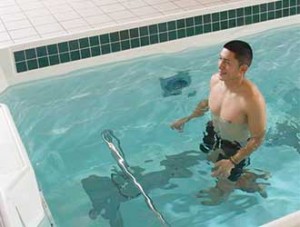Aquatic Therapy For SLAP Repair
Working with patients who have shoulder injuries, and especially those who have been through SLAP (superior labrum anterior and posterior) repair surgery, can be tricky. Patients often worry about pain, tightness and re-injury during land-based physical therapy sessions, leading them to perform less intensely and ultimately take longer to achieve their post-op goals.
This is the reason athletic trainers and physical therapy professionals are actively looking for better ways to help their SLAP repair patients, including with the use of aquatic therapy modalities.
If you’ve been interested in this topic, and want to help your SLAP repair patients heal more efficiently and safely, you’ll enjoy our latest on-demand HydroWorx webinar, “The Rehabilitation of a Professional Baseball Player Post-Op SLAP Repair Incorporating the Use of Aquatic Therapy.” Presented by Ryan Bitzel, the Rehabilitation Coordinator for the San Diego Padres since 2010, the far-reaching webinar is relevant for anyone working with SLAP repair patients, whether those patients are athletes or not.
Watch the webinar on-demand now>>
The Anatomy of SLAP Injuries
Bitzel begins his webinar with a thorough examination of the anatomy of the shoulder. From discussions of the glenohumeral joint to an in-depth look at the labrum, he leaves no stone unturned. Not only does he provide an excellent refresher on the characteristics and operations of the shoulder, but he sets the stage for webinar participants to dive into aquatic therapy based on science and medicine.
When healthy, the labrum provides joint stability. When a trauma or repetitive overuse occurs, trouble begins. Athletes who use overhead motions, like pitchers, tend to suffer from repetitive overuse. Micro-traumas to the labrum create a problematic atmosphere. There are several theories of why micro-traumas happen, including eccentric load to the bicep, peel-off mechanisms and micro-instability. Bitzel goes into a comprehensive discussion of each, supporting his analysis with research-based evidence.
Interestingly, although 83% of pitchers have SLAP tears, not all pitchers should or do undergo operations. In general, surgical interventions are only performed when the SLAP tear is symptomatic and the player can no longer perform. At that point, conservative treatment measures are usually preferred unless surgery is unavoidable because of increasing pain and lessening function.
What Happens After SLAP Surgery?
With the stage set, Bitzel launches into a deeper explanation of the four post-op phases: reduction of swelling and restoration of range; restoration of strength; functional restoration; and return to activity/play. Each phase has specific milestones that need to be met for the patient to move to the next one.
Aquatic Therapy for SLAP
The answer is contained in water’s natural properties of heat, buoyancy, resistance and hydrostatic pressure. For those attendees not familiar with how to make use of water’s attributes, Bitzel’s discussion provides tremendous information. For those attendees who regularly use aquatic therapy with their patients, the presentation serves as a great reminder of just how valuable water therapy can be.
It should be noted that the physical properties of water aren’t the only positive benefits of post-op aquatic therapy. The psychological effect is just as encouraging, and plays a significant role in moving a patient from one post-op phase to another.
SLAP Repair Case Study
The last third of “The Rehabilitation of a Professional Baseball Player Post-Op SLAP Repair Incorporating the Use of Aquatic Therapy” looks at a real-life case study of a 23-year-old, right-handed starting pitcher with a history of internal impingement and lateral strains. His constant, nagging shoulder pain in May 2016 worsened to the point that he was unable to play. Ultimately, he underwent SLAP surgery.
Post-op, the player exhibited a negative attitude toward physical therapy. Guarded and fearful of moving, he began to lag behind where he should have been in terms of healing. Three weeks after his surgery, Bitzel introduced him to exercises in their aquatic therapy pool. Eventually, the player became more confident, alternating days between physical therapy in the pool, and physical therapy on land. According to Bitzel, the pitcher is now 16 weeks post-op and progressing on target.
Watch The SLAP Webinar
Watch “The Rehabilitation of a Professional Baseball Player Post-Op SLAP Repair Incorporating the Use of Aquatic Therapy”>>. It provides a wealth of critical, hands-on information and ideas regarding SLAP repair patients and hydrotherapy.



